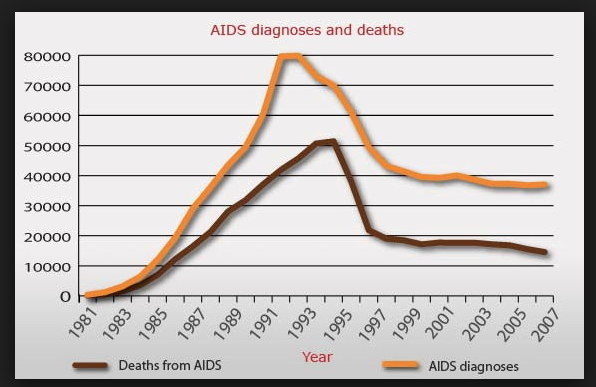 If you are 40 or younger, it is virtually impossible to fully comprehend the absolute horror of what life was like when AIDS first made its appearance. The infection was so new, and the brutal way in which it killed HIV-infected people could have easily been a post-apocalyptic sci-fi novel.
If you are 40 or younger, it is virtually impossible to fully comprehend the absolute horror of what life was like when AIDS first made its appearance. The infection was so new, and the brutal way in which it killed HIV-infected people could have easily been a post-apocalyptic sci-fi novel.
But, this wasn t science fiction. It was all too real. Before scientists was able to identify the pathogen and how learn how it was spread, it wasn't too much of a stretch to envision an end of the world scenarios. Yes it was that scary.
In 2010, Dr. Josh Bloom, the Director of Chemical and Pharmaceutical Science at the American Council on Science and Health, wrote a monograph entitled What Ever Happened to AIDS. How the Pharmaceutical Industry Tamed HIV, in which he discussed the transformation of AIDS from a sure death sentence to a manageable disease. It is obvious from the monograph that the first 14 years or AIDS were not pretty.
We are now 34 years past the date when the virus, which would later be named HIV, appeared in the literature for the first time. At that time, no one could have possibly imagined what life with HIV was going to be like three decades later. The change has been that profound.
Why? New drugs. Period. The evil pharmaceutical industry went full force into HIV research. Virtually every company was involved. Despite massive research efforts, most of these companies would not even come close to recouping their costs from what is arguably the single greatest public health accomplishment since the polio vaccine.
The astounding drop in deaths in the U.S. that began in 1996 is no accident. Four months after Roche got approval (December 1995) for Invirase, the first HIV protease inhibitor, the annual death rate in the U.S. fell by 64 percent. Invirase made the long sought after AIDS cocktail possible, since it operated by a different mechanism than all of the existing drugs at the time.

New and better antiviral drugs dozens of them would follow. One of them, Gilead's Truvada, was approved by the FDA in 2004. Truvada is the standard of care in developing nations (although it works just fine here as well). It has produced some truly amazing results, especially in Africa. In clinical trials, Truvada largely prevented the spread of the infection in serodiscordant couples (one person infected, the other not).
Other cocktail therapies have been so effective in shutting down the replication of the virus that the life span of HIV+ people is now predicted to be similar that of the general population.
In 2011, Dr. Bloom wrote in Medical Progress Today about how these results could signal the beginning of the end of the global AIDS epidemic. The real life results in Africa are mixed, since preventing the transmission of the virus is highly dependent dependent on patient compliance, which has been a nagging problem. (Truvada was approved by the FDA for prophylactic use in 2012).
But, the compliance problems were not an issue in Cuba. The country has taken prevention a big step further. It is the first country in the world to prevent another critical means of infection the transmission of the virus from HIV+ mothers to their fetuses. This occurs between 15 and 45 percent of the time without pharmaceutical intervention. With proper treatment, this number drops to less than 1 percent.
This is a very big deal, which is obvious from the comments of Dr. Margaret Chan, the director general of the WHO said, [this] is one of the greatest public health achievements possible, [and] an important step towards an Aids-free generation.
Amazing.


